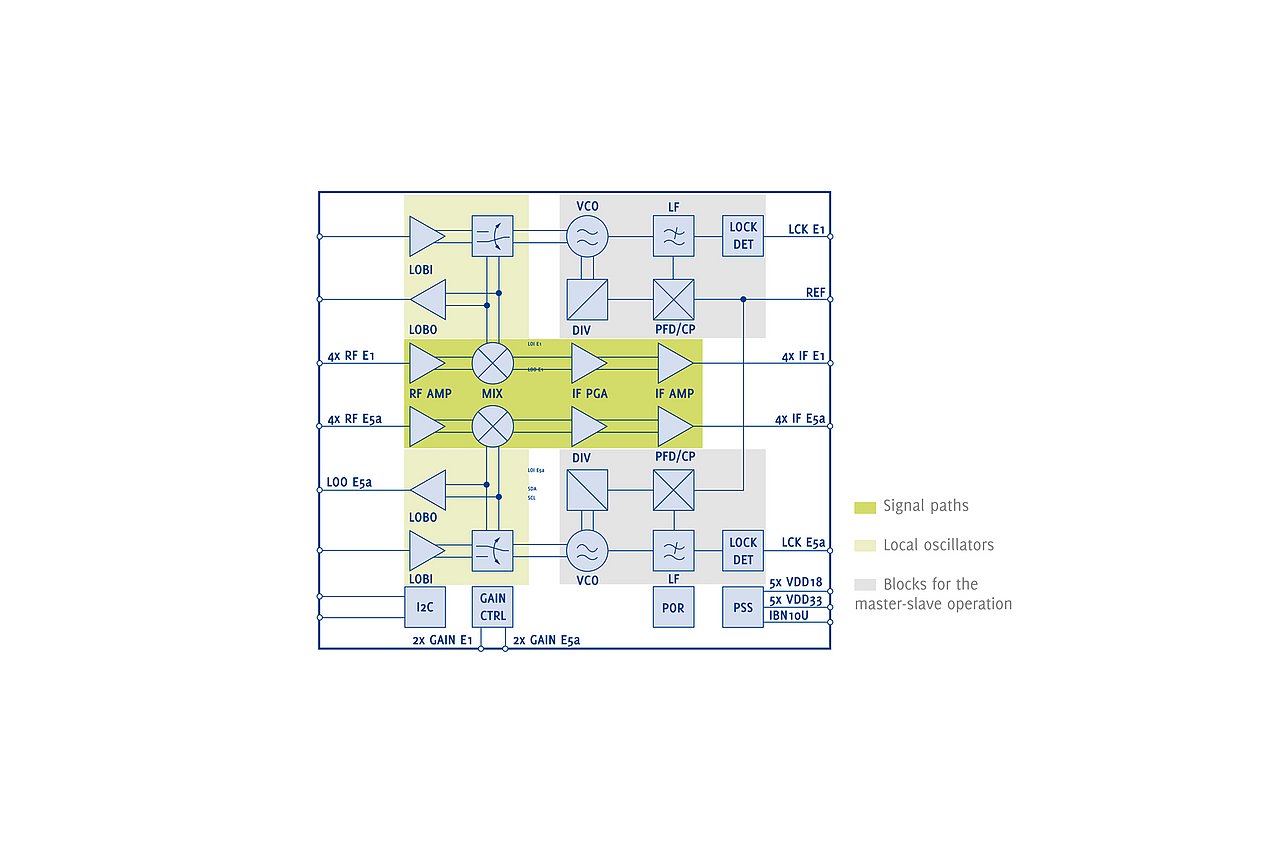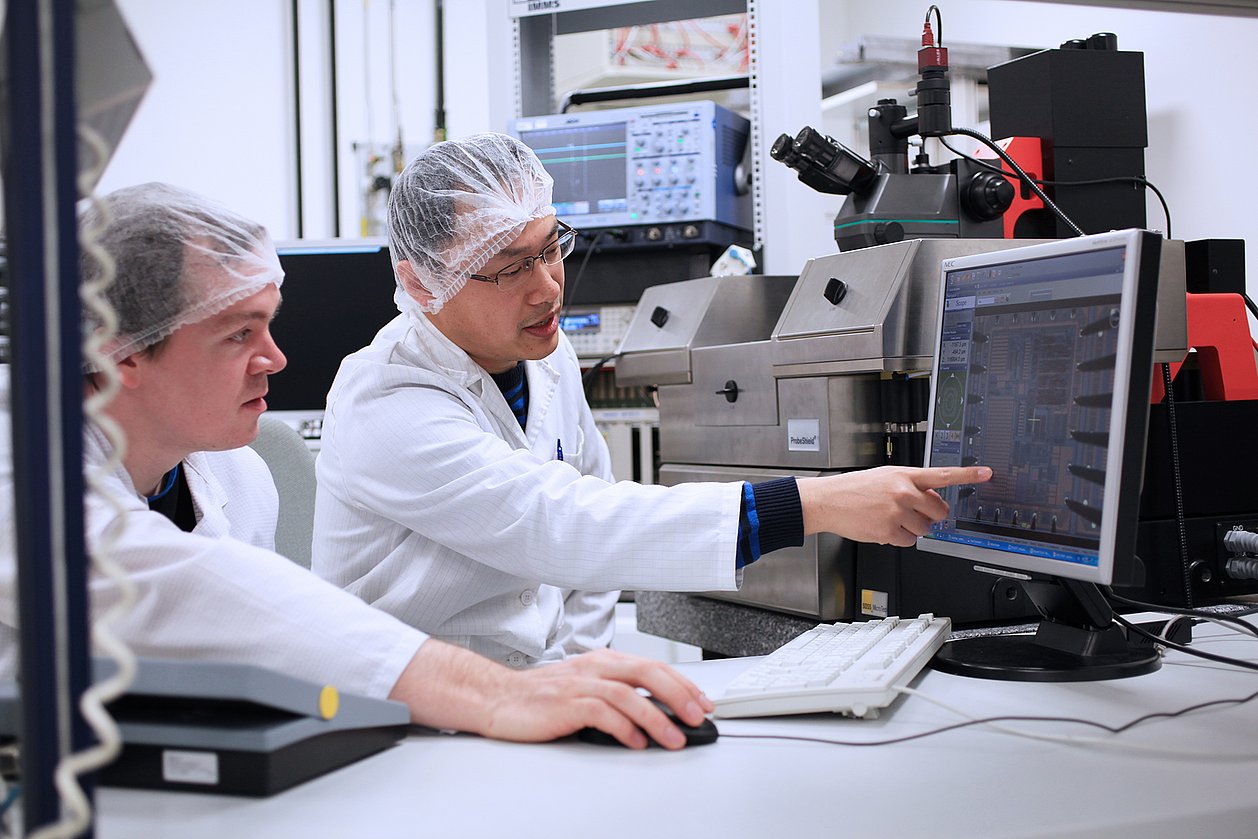Project KOSERNA
For fail-safe navigation, IMMS has developed the circuit for a receiving unit to prepare satellite signals for interference suppression.
Objectives
The transport of goods, the observation of public events, the measurement of buildings, the tasks and the inspection of agriculture – these are only a few of the ways in which mobile systems such as multicopters can be used. If these aerial systems are to be sent out to do their job without human intervention in situations where security and safety are critical, there will always be a need for navigation that is robust, absolutely accurate and proof against interruption or hacking.
This is clear from the example of civilian UAVs (unmanned aerial vehicles). It is only by dint of spot-on, fail-safe navigation that a prescribed route can be followed so exactly that collisions are avoided, flying height kept within limits, no-fly zones avoided, and, in the event of a loss of communication, homing and automatic landing achieved – without any breach of the laws that apply.
Problem
For safety-critical autonomous navigation purposes, commonly and commercially available satnav equipment is out of the question for two reasons: potential breaks or errors in the positioning function, and susceptibility to interference. Satnavs receive their signals from satellites more than 20,000 kilometres away, which means those signals are very weak on arrival and that they are susceptible to the deliberate interference known as GNSS-jamming from transmitters able to send signals perhaps more than a hundred times their strength. Hijacking of the flying object itself is also a possibility.
Solution (step 1): a compact four-channel GNSS receiver
For these reasons it fell to the German Aerospace Centre (DLR), the Ilmenau University of Technology, the RWTH Aachen and IMMS to research new designs, technology and algorithms for the sort of more compact adaptive group antennas necessary to eliminate satnav signal disruption. These are capable of fulfilling very high interference-mitigation specifications, but those developed so far were too large and heavy for actual mobile use. A receiving unit was designed by IMMS and partners which was only a quarter of the size of a conventional group antenna but had the same number of individual elements. It has proved the applicability of the signal treatment techniques. IMMS’ part was to develop the receiver front end circuit forming the link between the antenna array and the digital evaluation software.
Solution (step 2): fail-safe and more compact receiver with 16 channels for increased accuracy and robustness
In the KOSERNA project the same partners have constructed an industrial prototype on the basis of the results achieved in 2013 in conjunction with the antenna engineering company Antennentechnik Bad Blankenburg GmbH. In parallel, the partners have worked on the issues of significantly increased accuracy and robustness for a novel receiver unit. For it, IMMS as subcontractor to Ilmenau TU (Technische Universität) has extended the frontend circuits and transferred the new principles onto a second frequency band. The new prototype was fully tested at the Automotive Galileo Test Environment (GATE) in Aldenhoven, Germany. Good results were obtained in a number of test drives in real situations exposed potentially to disruption with which the standard GPS equipment commercially available would fail to cope.
Acronym / Name:
KOSERNA / Compact Satellite Receiver Systems for Robust Navigation ApplicationsDuration:2014 – 2016
Application:
|Autonomous navigation · safety-critical navigation · Traffic engineering · transportResearch field:Integrated sensor systems
Related content
Test von HF-Frontends für Navigationsanwendungen – Evaluierung von mehrkanaligen GNSS-Empfängern mit realen Satellitensignalen
Bjoern Bieske1. Kurt Blau2.30. GI/GMM/ITG-Workshop, Testmethoden und Zuverlässigkeit von Schaltungen und Systemen (TuZ 2018), 4.-6. März 2018, Freiburg im Breisgau, Germany
1IMMS Institut für Mikroelektronik- und Mechatronik-Systeme gemeinnützige GmbH, 98693 Ilmenau, Germany. 2TU Ilmenau, Germany.Feasibility of Dual-polarized Antenna Arrays for GNSS Receivers at Low Elevations
Maysam Ibraheam1. Bjoern Bieske2. Kurt Blau1. Eric Schäfer2. André Jäger2. Safwat Irteza Butt3. Ralf Stephan1. Matthias A. Hein1.2017 11th European Conference on Antennas and Propagation (EUCAP), Paris, 19-24 March 2017, pp. 857-861. DOI: doi.org/10.23919/EuCAP.2017.7928441
1Thuringian Center of Innovation in Mobility, RF and Microwave Research Laboratory, Technische Universität Ilmenau, Germany. 2IMMS Institut für Mikroelektronik- und Mechatronik-Systeme gemeinnützige GmbH, 98693 Ilmenau, Germany. 3Robert Bosch GmbH, Stuttgart, Germany.Compact antenna array receiver for robust satellite navigation systems
S. Irteza1. E. Schäfer2. R. Stephan1. A. Hornbostel3. M. A. Hein1.International Journal of Microwave and Wireless Technologies, 7(6), 735-745, DOI: dx.doi.org/10.1017/S1759078714000907
1Technische Universität Ilmenau, Fachgebiet Hochfrequenz- und Mikrowellentechnik, Ilmenau. 2IMMS Institut für Mikroelektronik- und Mechatronik-Systeme gemeinnützige GmbH, Ilmenau. 3German Aerospace Center (DLR), Oberpfaffenhofen, Germany.Beamforming in compact antenna arrays for robust satellite navigation
S. Irteza1. E. Schäfer2. M. Ibraheam1. B. Bieske2. R. Stephan1. M.A. Hein1.Antennas and Propagation in Wireless Communications (APWC), 2014 IEEE-APS Topical Conference on, Pages 528 – 531, SOI: dx.doi.org/10.1109/APWC.2014.6905569
1Technische Universität Ilmenau, Fachgebiet Hochfrequenz- und Mikrowellentechnik, Ilmenau. 2IMMS Institut für Mikroelektronik- und Mechatronik-Systeme gemeinnützige GmbH, Ilmenau.

Event,
TuZ 2018
Contact
Contact
Eric Schäfer, M. Sc.
Head of Microelectronics / Branch Office Erfurt
eric.schaefer(at)imms.de+49 (0) 361 663 25 35
Eric Schäfer and his team research Integrated sensor systems, especially CMOS-based biosensors, ULP sensor systems and AI-based design and test automation. The results are being incorporated into research on the lead applications Sensor systems for in-vitro diagnostics and RFID sensor technology. It will assist you with services for the development of Integrated circuits and with IC design methods.
Funding
IMMS has acted as R&D subcontractor to the Technische Universität Ilmenau in the KOSERNA project. It has been funded by the German Federal Ministry for Economic Affairs and Energy (BMWi) via the German Aerospace Centre (DLR). The reference is 50 NA 1405.











![[Translate to English:] [Translate to English:]](/fileadmin/_processed_/a/7/csm_20130223_dcSen_ProberEF_MM_MG_3325_1920x1280_588e478d86.jpg)